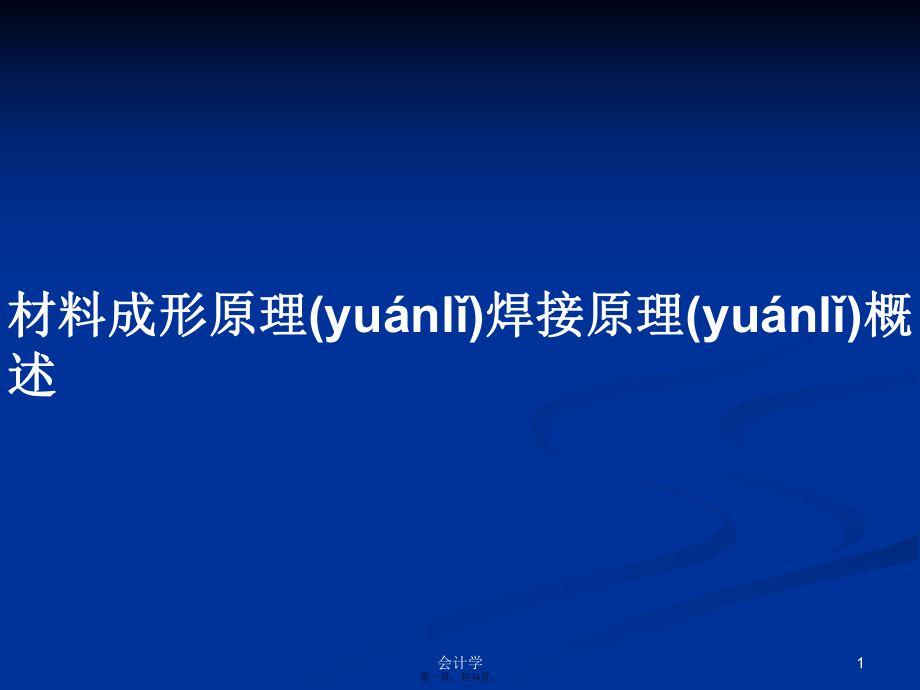 材料成形原理焊接原理概述学习教案
材料成形原理焊接原理概述学习教案



《材料成形原理焊接原理概述学习教案》由会员分享,可在线阅读,更多相关《材料成形原理焊接原理概述学习教案(34页珍藏版)》请在装配图网上搜索。
1、会计学1材料成形原理材料成形原理(yunl)焊接原理焊接原理(yunl)概概述述第一页,共34页。1.1 连接与人类(rnli)历史自石器时代至今天(jntin)连接始终是人类制造业中最为重要的工艺过程之一材料成形原理-焊接原理(序论) 3第2页/共34页第1页/共34页第二页,共34页。材料成形原理(yunl)-焊接原理(yunl)(序论) 41.2 连接的定义、目的(md)及基本分类1.2.1 连接的定义第3页/共34页第2页/共34页第三页,共34页。Figure 1.1 Welding, using a variety of fusion welding, predominantly
2、consumable electrode processes, is used almost exclusively in ship construction. Roll product (e.g., plate and beams), forgings, and castings are all welded to provide structural integrity, structural efficiency, and leak tightness. In most shipyards parts are joined to create large pre-fabricated m
3、odules, which are then joined to produce the ship, here the aircraft carrier Reagan.大型(dxng)结构材料(cilio)成形原理-焊接原理(序论) 5第4页/共34页第3页/共34页第四页,共34页。Figure 1.2 Modern manufacturing often benefits when labor-intensive, quality-critical assembly is automated, as exemplified in the automobile industry by rob
4、otic welding. (Courtesy of DaimlerChrysler AG, Stuttgart, Germany, with permission.)中型(zhngxng)结构材料成形原理-焊接(hnji)原理(序论) 6第5页/共34页第4页/共34页第五页,共34页。Figure 1.3 Welding is also used for microjoining for a variety of applications and industries. Here, very thin kovar sheets are spot-fillet welded by laser
5、-beam welding to produce the minute lap joints shown. (Courtesy of Sandia National Laboratories, Albuquerque, NM, with permission.)微小(wixio)结构材料成形原理(yunl)-焊接原理(yunl)(序论) 7第6页/共34页第5页/共34页第六页,共34页。Figure 1.4 Typical large welded structures at a petrochemical plant. Note the bolted thick-section pipes
6、, valves, and fittings at the left and right of the welded towers, as shown in a close-up in Figure 2.3. (Courtesy of Marathon Ashland Petroleum LLC, Findlay, OH, with permission.)金属材料材料成形原理-焊接(hnji)原理(序论) 8第7页/共34页第6页/共34页第七页,共34页。Figure 1.5 Typical use of manual iron soldering in industry. (Courte
7、sy of the IBM Corporation, Poughkeepsie, NY, with permission.)Figure 1.6 An example of a friction-welded ceramic assembly. (Courtesy of the Edison Welding Institute, Columbus, OH, with permission.)陶瓷(toc)+金属材料成形原理(yunl)-焊接原理(yunl)(序论) 9第8页/共34页第7页/共34页第八页,共34页。Figure 1.7 The use of thermal bonding,
8、as well as adhesive bonding, is commonplace in the assembly of thermoplastic monolithic and reinforced composites used in military aircraft. (Courtesy of Northrop Grumman Corporation, with permission.)复合材料(f h ci lio)材料成形原理-焊接(hnji)原理(序论) 10第9页/共34页第8页/共34页第九页,共34页。Figure 1.8 In an analog to welding
9、, a laser beam can be used to reattach a detached retina, with the heat of the laser causing joining by coagulating protein. (Courtesy of Julia A. Haller, M.D., The Johns Hopkins Hospital, Baltimore, MD, with permission.)生物(shngw)材料材料(cilio)成形原理-焊接原理(序论) 11第10页/共34页第9页/共34页第十页,共34页。Figure 1.9 Huge o
10、ffshore drilling platforms, serving as self-sufficient cities at sea, use welding extensively in their land-based construction, on-site erection, and above and below water repair. (Courtesy of Materials & Welding Technology, Houston, TX, with permission.) VA, with permission.)Figure 1.10 Underwater
11、arc welding is necessary for both construction and repair. Here, a diver is shown arc-repair welding an obviously overgrown steel structure. (Courtesy of Daves Diving & Offshore, in memory of Chris Mourtinson, Morgan City, LA, with permissionof David Gilbert.)海材料成形(chn xn)原理-焊接原理(序论) 12第11页/共34页第10页
12、/共34页第十一页,共34页。Figure 1.11 Welding is used to construct overland pipelines in all kinds of climates, including frozen tundra or scorching deserts, as shown here. (Courtesy of Bechtel Corporation, San Francisco, CA, with permission.)陆材料成形(chn xn)原理-焊接原理(序论) 13第12页/共34页第11页/共34页第十二页,共34页。Figure 1.12 A
13、s humans venture farther and stay longer in outer space, joining by specially adapted conventional processes as well as yet-to-be-developed processes will be a necessity. Here, an astronaut assembles new parts onto a portion of the InternationalOrbiting Space Station. (Courtesy of the National Aeron
14、autics and Space Administration,Washington, DC, with permission.)天材料成形原理(yunl)-焊接原理(yunl)(序论) 14第13页/共34页第12页/共34页第十三页,共34页。材料(cilio)成形原理-焊接原理(序论) 151.2.2 连接(linji)的目的(2)可制造性:利用已有构件和材料达到整体结构构造的有效性;获得单一工艺方法无法获得的大尺寸或复杂结构构件将适合的材料用于适合的位置,优化选择;充分利用材料,尽量减少材料的消耗。(3)成本(4)美学重要性第14页/共34页第13页/共34页第十四页,共34页。连接(
15、linji)(Joining)机械(jxi)连接(Mechanical Fasteners, Riveting)粘接(Adhesive Bonding and Cementing)焊接焊接(Welding, Braze, solder and diffusion bonding)机械力(弹、塑性畸变)强度低、非密封范德华力 、氢键强度低、密封金属键,共价键,离子键强度高、密封材料成形原理-焊接原理(序论) 16第15页/共34页第14页/共34页第十五页,共34页。1.3.1 焊接基本(jbn)方法材料成形原理-焊接(hnji)原理(序论) 17第16页/共34页第15页/共34页第十六页,共
16、34页。焊焊熔焊熔焊(rn hn)压焊压焊钎焊钎焊(qin hn)电弧焊电弧焊气焊气焊铝热焊铝热焊电渣焊电渣焊电子束焊电子束焊激光焊激光焊电阻点(缝)焊电阻点(缝)焊熔化极熔化极手工电弧焊手工电弧焊氩弧焊氩弧焊(MIG)埋弧焊埋弧焊(SAW)CO2焊焊螺柱焊螺柱焊非熔化极非熔化极钨极氩弧焊钨极氩弧焊(TIG)等离子弧焊等离子弧焊(PAW)原子氢焊原子氢焊摩擦焊摩擦焊扩散焊扩散焊爆炸焊爆炸焊超声波焊超声波焊冷压焊冷压焊电阻焊、闪光对焊电阻焊、闪光对焊材料成形原理-焊接原理(序论) 18第17页/共34页第16页/共34页第十七页,共34页。Figure 1.13 气体(qt)保护钨极电弧焊( G
17、as-Tungsten Arc Welding; GTAW )。示意图 (Reprinted from Joining of Advanced Materials, Robert W. Messler, Jr., Fig. 6.9, page 202, Butterworth-Heinemann, Stoneham, MA, 1993)材料(cilio)成形原理-焊接原理(序论) 19第18页/共34页第17页/共34页第十八页,共34页。Figure 1.14 气体保护(boh)熔化极电弧焊(gas-metal arc welding; GMAW)示意图 。(Reprinted from J
18、oining of Advanced Materials, Robert W. Messler, Jr., Fig. 6.16, page 208, Butterworth-Heinemann, Stoneham, MA, 1993)材料成形(chn xn)原理-焊接原理(序论) 20第19页/共34页第18页/共34页第十九页,共34页。Figure 1.15 手工(shugng)电弧焊(shielded metal arc welding; SMAW )示意图 。(Reprinted from Joining of Advanced Materials, Robert W. Messler
19、, Jr., Fig. 6.18, page 211, Butterworth-Heinemann, Stoneham, MA, 1993)材料成形(chn xn)原理-焊接原理(序论) 21第20页/共34页第19页/共34页第二十页,共34页。Figure 1.16 药芯焊丝(hn s)电弧焊(flux-cored arc welding; FCAW)示意图 。(Reprinted from Joining of Advanced Materials, Robert W. Messler, Jr., Fig. 6.19, page 213, Butterworth-Heinemann, S
20、toneham, MA, 1993)材料成形原理-焊接(hnji)原理(序论) 22第21页/共34页第20页/共34页第二十一页,共34页。Figure 1.17 埋弧焊(submerged arc welding; SAW)示意图。 (Reprinted from Joining of Advanced Materials, Robert W. Messler, Jr., Fig. 6.20, page 213, Butterworth-Heinemann, Stoneham, MA, 1993)材料(cilio)成形原理-焊接原理(序论) 23第22页/共34页第21页/共34页第二十二
21、页,共34页。Figure 1.18 电渣焊(electroslag welding; ESW)示意图 。(Reprinted from Joining of Advanced Materials, Robert W. Messler, Jr., Figs. 6.21 and 6.22, page 215, Butterworth-Heinemann, Stoneham, MA, 1993)材料成形(chn xn)原理-焊接原理(序论) 24第23页/共34页第22页/共34页第二十三页,共34页。Figure 1.19 电阻(dinz)点焊(resistance spot welding;
22、RSW)示意图。(Reprinted from Joining of Advanced Materials, Robert W. Messler, Jr., Fig. 6.24, page 218, Butterworth-Heinemann, Stoneham, MA, 1993)材料成形原理(yunl)-焊接原理(yunl)(序论) 25第24页/共34页第23页/共34页第二十四页,共34页。Figure 1.20 (a) 爆炸焊示意图(explosion welding; EXW); (b)爆炸焊典型(dinxng)形貌。 (Reprinted from Joining of Adva
23、nced Materials, Robert W. Messler, Jr., Fig. 6.28, page 224, Butterworth-Heinemann, Stoneham, MA, 1993)材料(cilio)成形原理-焊接原理(序论) 26第25页/共34页第24页/共34页第二十五页,共34页。Figure 1.21 (a) 摩擦(mc)焊(friction welding; FRW)示意图; (b) 典型摩擦(mc)焊接头。 (Reprinted from Joining of Advanced Materials, Robert W. Messler, Jr., Fig.
24、 6.29, page 225, Butterworth-Heinemann, Stoneham, MA, 1993)材料成形原理(yunl)-焊接原理(yunl)(序论) 27第26页/共34页第25页/共34页第二十六页,共34页。1.3.2 焊接(hnji)的定义两种或两种以上的材料,在添加或不添加填充材料的条件下,通过加热、加压,或二者并用的外场形式,并借助物质迁移过程,消除接触表面、形成永久性、致密、高强(goqing)接头的物理化学过程。材料成形原理-焊接原理(序论) 28第27页/共34页第26页/共34页第二十七页,共34页。1.3.3 不同焊接方法所需外场(wichng)(温
25、度、压力)s2s3s4sTmTb激光电子束电弧电渣气焊扩散接触超声冷压磁脉冲爆炸磨擦0.111010010000.111010010000.010t/sP图1-22 不同焊接(hnji)方法作用温度、压力及过程持续时间的对比材料成形原理(yunl)-焊接原理(yunl)(序论) 29第28页/共34页第27页/共34页第二十八页,共34页。1.3.4 焊接(hnji)的物理本质 图1-24 固-固硬球结构(jigu)模型 图1-23 固-液硬球结构模型 材料(cilio)成形原理-焊接原理(序论) 30第29页/共34页第28页/共34页第二十九页,共34页。nmrarbrafffnmrA)5
26、 . 03 . 0(图1-2 原子间作用力与距离(jl)关系1斥力;2引力;3合力材料成形(chn xn)原理-焊接原理(序论) 31莱纳德-琼斯势nnmmrArArV)(Lennard-Jones按求极限法则可得到与最大净作用力对应的原子间距为标准的莱纳德-琼斯势,m=6,n=12,An、Am的数据可以根据点阵参数和升华能的数据导出第30页/共34页第29页/共34页第三十页,共34页。作用(zuyng)本质加热(ji r)形成(xngchng)L/L、L/S界面对接触接头进行局部加热,借助熔化、液相融合过程消除L/L界面;借助凝固过程消除L/S界面加热/加压形成S/S界面借助热激活、畸变能
27、激活,促进S/S接触界面的塑性变形、原子互扩散与成键消除S/S界面材料成形原理-焊接原理(序论) 32第31页/共34页第30页/共34页第三十一页,共34页。图1-25 焊接接头示意图:1. 焊缝(hn fn);2. 熔合区;3. 热影响区;4. 未变化的母材3124材料成形(chn xn)原理-焊接原理(序论) 33第32页/共34页第31页/共34页第三十二页,共34页。Ti at.%Al at.%Cr at.%Nb at.%Cu at.%Ni at.%A167.129.11.20.41.40.8B163282.40.73.62.4C173.724.60.30.10.80.4D17013
28、.40.90.287.5E1626.30.5-625.5F157.811.90.2-13.916.3G150.85.40.7-18.624.6图1-26 钎焊(qin hn)接头示意图: 1扩散区;2界面区;3钎缝中心区 -TiAl钎焊接头微观(wigun)结构及成份分布(Ti5 wt.%Cu15 wt.%Ni钎料)材料成形原理-焊接(hnji)原理(序论) 34第33页/共34页第32页/共34页第三十三页,共34页。局部(jb)加热的超高温度场组织(zzh)的不均匀性力学性能不均匀(jnyn)性残余热应力分布连接材料的氧化倾向特有缺陷的产生材料成形原理-焊接原理(序论) 35以熔焊为代表整体加热的高温度场接头组织的特殊性以钎焊、扩散焊(也有局部加热的情况) 为代表残余热应力分布连接材料的氧化倾向特有缺陷的产生1.3.5 不同焊接方法所涉及的基本原理第34页/共34页第33页/共34页第三十四页,共34页。
- 温馨提示:
1: 本站所有资源如无特殊说明,都需要本地电脑安装OFFICE2007和PDF阅读器。图纸软件为CAD,CAXA,PROE,UG,SolidWorks等.压缩文件请下载最新的WinRAR软件解压。
2: 本站的文档不包含任何第三方提供的附件图纸等,如果需要附件,请联系上传者。文件的所有权益归上传用户所有。
3.本站RAR压缩包中若带图纸,网页内容里面会有图纸预览,若没有图纸预览就没有图纸。
4. 未经权益所有人同意不得将文件中的内容挪作商业或盈利用途。
5. 装配图网仅提供信息存储空间,仅对用户上传内容的表现方式做保护处理,对用户上传分享的文档内容本身不做任何修改或编辑,并不能对任何下载内容负责。
6. 下载文件中如有侵权或不适当内容,请与我们联系,我们立即纠正。
7. 本站不保证下载资源的准确性、安全性和完整性, 同时也不承担用户因使用这些下载资源对自己和他人造成任何形式的伤害或损失。
最新文档
- 沪教牛津英语六年级上册Module3单元全套ppt课件
- 沪科版《声音的产生与传播》ppt课件
- 店铺数据分析课件
- 美国研究文献资源指南.课件
- 绿色夏天清新汇报课件
- 美食咖啡下午茶餐饮课件
- 微生物学实验-1-口腔微生物的染色观察与显微镜油镜的使用;细菌的革兰氏染色教学课件
- 沪教版(上海)七年级数学第二学期ppt课件152(2)直角坐标平面内点的运动
- 店铺报告模本教学课件
- 民兵组织建设课件
- 沪教版(上海)七年级数学第二学期ppt课件152(1)直角坐标平面内点的运动
- 沪教版牛津英语小学二年级上学期期末复习句型课件
- 沪教版地理七年级上册42黄河课件
- 沪教版五年级数学下册《正方体、长方体的表面积2》ppt课件
- 微生物学基础知识培训课件
